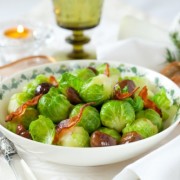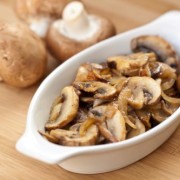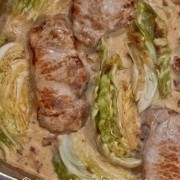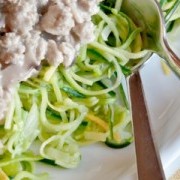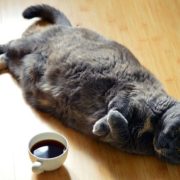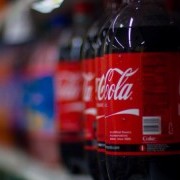SANE Science
Simple Science: How Excess Insulin Makes Us Fat
SANE Science“…obesity is impossible in the absence of adequate tissue concentrations of insulin.” – M. Goldberg, in Journal of the American Medical Association
In the last post we touched on how hormones control the metabolic conversation that determines if we are storing or burning body fat. Let’s now dig into the hormone insulin’s role in this conversation as it is known in scientific circles as, “The most important hormonal factor influencing lipogenesis [body fat creation].”
Insulin’s job is to get energy into cells. For example, after we eat lunch, our body digests it and then releases insulin to carry those freshly digested calories into our cells. Since insulin is activated only when we need to get fuel into our cells, our metabolism “hears” insulin in the bloodstream “communicating” that we have energy on its way to our cells and therefore do not need to use any stored energy—aka burn body fat. So the hormone insulin—not the calories we ate—blocks the burning of body fat. That point is extremely important.
“[Insulin signals an] abundance of [external] energy, [and]…fat breakdown is suppressed and its synthesis promoted…” – researcher G. Wilcox, Mepoundourne Pathology
Our metabolism does not decide to burn or store body fat based on calories. It makes these decisions based on the hormones those calories trigger. That is why the quality of calories matters so much. As we have already seen, higher-quality calories trigger body-fat-burning hormones while low-quality calories trigger body-fat-storing hormones.
“Fat is mobilized [burned] when insulin secretion diminishes.” – The American Medical Association
We can cut calories all day and will not burn body fat effectively if we are eating low-quality calories which trigger excess body-fat-storing hormones such as insulin. Why? Hormones like insulin remove our ability to burn body fat regardless of whether or not we need to according to calorie quantity. That is why scientists refer to the hormone insulin as the “principal regulator of fat metabolism.”
Here is the sad part. Calories from inSANE starch and sweets trigger the release of ridiculous amounts of insulin. All that insulin gets those inSANE starch and sweets’ calories into our cells, but then we still have insulin left over in our bloodstream. That excess insulin clogs us up and removes our ability to burn body fat.

Where the Average American Gets Calories
(Insulin-spiking starch and sweeteners make up 43% of what we eat)

“…obesity [is characterized by] defects in insulin action, whole-body insulin resistance, and hyperinsulinemia” – researcher D.A. York, Pennington Biomedical Research Center
Things go from bad to worse if this inSANEity keeps up for too long. Not only does all the excess insulin destroy our ability to burn body fat, it makes the metabolism resistant to insulin. How does this process work? Compare becoming resistant to the effects of insulin with becoming resistant to the effects of alcohol. When people drink alcohol in moderation, everything is fine. It takes relatively little alcohol to generate the desired effect, so people don’t drink too much of it. However, if people drink too much alcohol, they become resistant to alcohol’s effects. Then they have to drink more alcohol to get the desired effect. This volume of alcohol eventually destroys their liver and makes them gain body fat. This leaves heavy drinkers in an unfortunate place where they have become resistant to alcohol and have to drink an unhealthy amount of it to get the desired effect.
Similarly, when people eat mostly SANE foods and just a little inSANE starch and sweets, everything is fine. It takes little insulin to get energy into cells, so the body doesn’t produce too much of it. However, if people eat mostly starch and sweets, their bodies become resistant to insulin’s effects. Then their body has to produce more insulin to get energy into cells. This volume of insulin eventually destroys their pancreas and makes them gain body fat.
“Foods made from wheat flour account for about 20% of the calories in the American diet…” –Marion Nestle, New York University
Even more unfortunate, at least one in four Americans are insulin resistant. All this excess insulin forms the backbone of the hormonal dysfunction causing us to gain fat. Not only does it crush our ability to burn body fat, it also increases the rate at which we store body fat because excess insulin preferentially puts calories into our fat tissue. This happens because no matter how resistant other tissues become to insulin, our fat tissue is always receptive. And while that is technically good because it keeps insulin resistance from killing us, it can crush any dreams of losing weight. We end up with more body fat and no ability to burn it. This sad state is know as internal starvation and will be the subject of the next post.
- American Medical Association Council on Foods and Nutrition. A critique of low-carbohydrate ketogenic weight reduction regimens. A review of Dr. Atkins’ diet revolution. JAMA. 1973 Jun 4;224(10):1415-9. PubMed PMID: 4739993.
- “Diabetes mellitus.” Belinda Rowland., Teresa G. Odle., and Tish Davidson, A. M. The Gale Encyclopedia of Alternative Medicine. Ed. Laurie Fundukian. 3rd ed. Detroit: Gale, 2009. 4 vols.
- Blüher M, Michael MD, Peroni OD, Ueki K, Carter N, Kahn BB, Kahn CR. Adipose tissue selective insulin receptor knockout protects against obesity and obesity-related glucose intolerance. Dev Cell. 2002 Jul;3(1):25-38. PubMed PMID: 12110165.
- Cordain, Loren, and Joe Friel. The Paleo Diet for Athletes: A Nutritional Formula for Peak Athletic Performance. Emmaus, Pa.: Rodale Books, 2005. Print.
- E.A. Newsholme and C. Start. Regulation of Metabolism. 173 ISBN: 0471635308
- Flatt, Jen-Pierre. Tremblay, Angelo. Energy Expenditure and Substrate Oxidation. In: Bray GA, Couchard d, James WP, eds. Handbook of Obesity. New York: Marcel Dekker, 1997: 513-538.
- Goldberg M, Gordon E. Energy Metabolism In Human Obesity. Plasma Free Fatty Acid, Glucose, And Glycerol Response To Epinephrine. JAMA. 1964 Aug 24;189:616-23. PubMed PMID: 14162576.-
- Havel PJ. Update on adipocyte hormones: regulation of energy balance and carbohydrate/lipid metabolism. Diabetes. 2004 Feb;53 Suppl 1:S143-51. Review. PubMed PMID: 14749280.
- Ludwig DS. The glycemic index: physiological mechanisms relating to obesity, diabetes, and cardiovascular disease. JAMA. 2002 May 8;287(18):2414-23. Review. PubMed PMID: 11988062.
- Newsholme, E. A., and C. Start. Regulation in metabolism . London: Wiley, 1973. Print.
- Obesity and leanness. Basic aspects. Stock, M., Rothwell, N., Author Affiliation: Dep. Physiology, St. George’s Hospital Medical School, London Univ., London, UK.
- Schenk S, Saberi M, Olefsky JM. Insulin sensitivity: modulation by nutrients and inflammation. J Clin Invest. 2008 Sep;118(9):2992-3002. Review. PubMed PMID: 18769626; PubMed Central PMCID: PMC2522344.
- Whitehead, Saffron A.; Nussey, Stephen (2001). Endocrinology: an integrated approach. Oxford: BIOS. pp. 122. ISBN 1-85996-252-1.
- Wilcox G. Insulin and insulin resistance. Clin Biochem Rev. 2005 May;26(2):19-39. PubMed PMID: 16278749; PubMed Central PMCID: PMC1204764.
- York DA, Bray GA. Dependence of hypothalamic obesity on insulin, the pituitary and the adrenal gland. Endocrinology. 1972 Apr;90(4):885-94. PubMed PMID:4258778.
- York DA, Hansen B. Animal models of obesity. In: Bray GA, Couchard d, James WP, eds. Handbook of Obesity. New York: Marcel Dekker, 1997: 191-221

The Simple Reason We Have an Obesity Epidemic and the Surprising Solution
SANE Scienceby Adam Kosloff
Why do we get fat? What can we do to lose unwanted fat?
These questions are at the root of the biggest public health crisis in American history — arguably in the history of our species.
The universal diet advice, Eat Less and Exercise More, doesn’t seem to work for many of us. Still, health authorities relentlessly beat the Eat Less Move More drum. This view of obesity is highly moralistic. It blames the problem on the twin sins of Sloth and Gluttony and assures us that the cure lies in the twin virtues of Restraint and Productivity.

Where Does This Moralistic View Come From?
Weirdly, it comes from the laws of physics. Per the 1st Law of Thermodynamics, the law of energy conservation, when any growth occurs on your body, you must take in more energy (calories) than you burn off.
You can’t make something from nothing: When you gain fat, you must “eat more than you burn off.”
That’s why we believe that “overeating” makes us fat.
But here’s the rub. Something else must happen, too! Something that no one really thinks about. You also need to transform those calories into “stuff” on your body.
Think about it. How exactly does that cheeseburger and milkshake “become” fat on your thighs and hips? Biochemistry is required! The raw calories must transit through a process inside your body in order to get fixed as fat. For the sake of simplicity, we can call all the relevant biochemistry “The Black Box.”
To sum up: whenever any growth happens in your body, two things must occur:
- You need substrate (a.k.a. calories)
- You need biochemistry to turn the calories into your body’s tissues and structures (a.k.a. a black box)
So What “Counts” — Calories or the Black Box?
When we talk about anything related to body growing (other than your fat tissue, which we’ll get to in a second!), the answer is obvious. The Black Box counts, and Calories are a sideshow. For instance, eating “excess calories” does not cause a woman to grow tissue in the form of a baby. Similarly, if you want to stop your moustache from growing, you wouldn’t eat less and exercise more.
On a more serious note: no one tells cancer patients to starve themselves in the blind hope that the creation of this whole body “energy deficit” will selectively burn-off their tumors. We conceptualize cancer properly as a medical problem. It’s a problem of tissue in our body growing in an abnormal fashion. True, the tumor is hoarding energy. But to understand WHY it’s doing so and WHAT to do about it and HOW to do it, we need to appreciate and possibly manipulate the biochemical forces at work on the tumor itself.
The point, I hope, is clear. In all other cases of growth on the body, calories are always of secondary importance. Sure, substrate is needed. But we intuitively know that what really matter are the biochemical signals that regulate the growth. A.k.a. The Black Box!
In a pregnant woman, a complicated mixture of hormones, genes, enzymes and other signals drive the woman’s body to build the baby.
In a growing teen, growth hormone causes the growth spurt.
In our moustache guy, testosterone and other hair-growth-signals determine how, when and where his moustache will grow.
Did you see where we’re going with this?
The biochemical stuff that regulates how our bodies grow the way they do always matters, whether we’re talking about hair tissue, muscle tissue, bone tissue, tissue making up a baby, or… drumroll… fat tissue.
The calorie thing is a Red Herring. The conventional mental model — how we all learned how to think about fat loss and fat gain — is based on a logical error, the confusing of cause and effect.
This Changes Everything!
No longer should we ask “how can I eat less and exercise more?”
This question fails to address the core problem, which is that biochemical forces are, for whatever reason, causing you to store too much fat.
The key questions then become: “Why? On a biochemical level, what’s making my fat tissue suck up and hold onto excess fat? What’s messing up my Black Box? (or, as Jonathan would put it: What’s clogging up my sink?)”
A pregnant woman does not get bigger because she overeats. Otherwise anyone could grow a baby by overeating. Instead, she overeats because she is pregnant.
Imagine if she went on a low calorie diet while growing the baby. First of all, she’d quickly get really hungry. Secondly, her energy levels would crash. And if she really forced herself into an energy deficit — by going to the gym, taking appetite control pills, etc — she could maybe blunt the growth of the baby, but only at great cost to both her body and the body of her child.
Why? Because the growing fetus has its own energy needs: it’s in many ways “in business for itself,” and it will hoard calories at the expense of the mother’s other metabolic needs.
The same exact logic applies when we talk about obesity. Your fat tissue is getting bigger, or it has gotten bigger. That’s obvious. The fat is growing abnormally, as if it’s “in business for itself.” In many ways, it’s behaving exactly like a fetus or like a tumor, narcissistically sucking up calories without a care in the world about the rest of the body.
The question we must address is WHY?
Once you’ve changed your perspective, the problem of obesity becomes much more tractable. We can start asking the right questions — finally!
Instead of wasting time fiddling around with calorie counters and treadmills and such nonsense, we can look for the REAL constraints that make people fat and keep them that way: The problems with the Black Box. Or, to use Jonathan Bailor’s apt metaphor, the hormonal clogs in our metabolic sink.
The good news is that, at least to a first degree, the answer appears to be remarkably simple: fix your diet to avoid consuming food that messes up your Black Box — or that “Clogs your Sink,” if you prefer. That’s it!
Obesity epidemic solved. Humanity saved. 🙂

Scientific Fact: Overeating Is Not The Cause Of Obesity
SANE Science
“Saying that obesity is caused by eating too much is like saying that allergies are caused by breathing too much.” – Jonathan Bailor
Commenting on his recent study at University of Colorado School of Medicine Dr. Guido Frank stated: “It is clear that in humans the brain’s reward system helps to regulate food intake…The specific role of these networks in eating disorders such as anorexia nervosa and, conversely, obesity, remains unclear.” Dr. Frank’s commentary reminded me of an analogy between anorexia and obesity that I find useful in illustrating how calorie quantity is not the cause of obesity and should not be our focus when trying to cure it.
A couple of posts back we covered the hormonally horrible condition known as internal starvation.
Internal Starvation: When the metabolism is so clogged that it encourages us to overeat to compensate for all the calories it is leaking into our fat cells.

We then looked at an example that showed how inSANE food causes the hormonal clog that leads to overeating and then obesity. More simply, that inSANE food is the cause of obesity. Not overeating. Chronically eating an excessive quantity of calories is a symptom of the metabolic disaster caused by inSANE low-quality calories.
While it took me a while to wrap my head around thinking of overeating as a symptom rather than a cause, I found that the thought process became easier when I flipped the problem on its head. By thinking about under-eating. By examining anorexia.
Let’s look at an example. Say we have an anorexic individual named Ann who heads to the doctor to get help. The doctor sits Ann down, looks at her chart, and tells Ann, “The cause of your problem is that you are eating too few calories. The solution to your problem is eating more calories.” We would all agree that doctor was not helpful. Ann knows she is eating too few calories. What she does not know is why she keeps eating too few calories. What she needs help with is the cause of her chronic low calorie consumption. Taking in too few calories is a symptom, not a cause. Making Ann aware of the cause is the key to helping her long term.
Like eating too few calories is not the cause of anorexia and focusing on calorie quantity does not lead to the solution, eating too many calories is not the cause of obesity and focusing on calorie quantity does not lead to the solution. Telling overweight individuals that they are eating too many calories is useless. Telling overweight individuals about the cause of their chronic high-calorie consumption (a hormonal clog cured via high-quality food and exercise) is useful. But as long as we are told calorie quantity is all that matters, we will never get that far. Why? Because the government, food, fitness, and pharmaceutical industries already believe they “know” the answer and therefore ignore the last forty years of scientific research proving the importance of food and exercise quality.
Consider this incorrect and condescending three-step weight loss plan from the American Council on Science and Health:
“1. Don’t expect a government bureaucracy to solve your problems.
2. Don’t single out one substance and complain that addiction to it has caused your lack of overall self-control.
3. When you’re ready to start dealing rationally with your weight problem, if you have one: eat less and/or exercise more.”
Why Focusing On Calorie Quantity Is Bad
It is a scientific fact that cure for obesity is not 100 calorie snack packs. It’s also not low-fat food products. And it’s definitely not about starving yourself until the suffering becomes unbearable. It’s not about calorie quantity at all. Until we free ourselves from this scientifically disproven theory, we will continue to experience the 95.4% failure rate of eating less and exercising more. So why do we keep hearing about counting calories and exercising excessively? In short, our government started and keeps fueling this fat-loss fiction to fund the food, fitness, and pharmaceutical industries.
We’ll start digging into that data in the next couple of posts.
“What could be better than an industry whose products do not work, or work only as long as you use them, for as long as you live, but whose customers believe that they have no other choice?” – Geoffrey Cannon
- Apoundu J. Pi-Sunyer F. Obesity and Diabetes In: Bray GA, Couchard d, James WP, eds. Handbook of Obesity. New York: Marcel Dekker, 1997: 697-707.
- Cannon, Geoffrey. Dieting Makes You Fat: The Scientifically Proven Way to be Slim without Lowering Your Food Intake. Revised edition ed. None: Virgin Books, 2008.
- Caro JF. Clinical review 26: Insulin resistance in obese and nonobese man. J Clin Endocrinol Metab. 1991 Oct;73(4):691-5. Review. PubMed PMID: 1890146.
- Cordain L, Eaton SB, Sebastian A, Mann N, Lindeberg S, Watkins BA, O’Keefe JH, Brand-Miller J. Origins and evolution of the Western diet: health implications for the 21st century. Am J Clin Nutr. 2005 Feb;81(2):341-54. Review. PubMed PMID: 15699220.
- DeFronzo RA, Ferrannini E. Insulin resistance. A multifaceted syndrome responsible for NIDDM, obesity, hypertension, dyslipidemia, and atherosclerotic cardiovascular disease. Diabetes Care. 1991 Mar;14(3):173-94. Review. PubMed PMID: 2044434.
- Kissebah AH, Peiris AN. Biology of regional body fat distribution: relationship to non-insulin-dependent diabetes mellitus. Diabetes Metab Rev. 1989 Mar;5(2):83-109. Review. PubMed PMID: 2647436.
- Knowler WC, Pettitt DJ, Savage PJ, Bennett PH. Diabetes incidence in Pima indians: contributions of obesity and parental diabetes. Am J Epidemiol. 1981
- Lamarche B, Tchernof A, Mauriege P, et al. Fasting insulin and apolipoprotein B levels and low-density lipoprotein particle size as risk factors for ischemic heart disease. JAMA. 1998;279:1955-1961.
- http://www.acsh.org/factsfears/newsID.727/news_detail.asp
- Crawford D, Jeffery RW, French SA. Can anyone successfully control their weight? Findings of a three year community-based study of men and women. Int J Obes Relat Metab Disord. 2000 Sep;24(9):1107-10. PubMed PMID: 11033978.
- Johnson D., Drenick E. J. (1977) therapeutic fasting in morbid obesity: long-term fellow-up. Arch. Intern. Med. 137:1381–1382

Can All Those Non-Starchy Vegetables Give Me Kidney Stones?
SANE ScienceCatherine Britell, M.D.
We love our non-starchy vegetables! And for most of us, eating ten or more servings of non-starchy vegetables (concentrating on the dark green ones) per day is the mainstay of a healthy diet. If you have had kidney stones, however, you’ll need to pay attention to the oxalate contained in the vegetables you eat. The good news: this is not difficult, and armed with the right information you can still enjoy plenty of low-oxalate non-starchy vegetables.
People who are overweight or obese need to be aware of the possibility of kidney stones. Compared with persons at or near ideal body weight (BMI = 21-23), obese men (BMI ≥30) have a 33% greater risk for kidney stone formation, while obese women have a 200% greater risk. ( Taylor EN, Stampfer MJ, Curhan GC. Obesity, weight gain, and the risk of kidney stones. JAMA. 2005;293:455-462)

We know that 75% of kidney stones are calcium oxalate stones, and oxalates in the diet can be important causative factors. So, for someone who has had one or more calcium oxalate kidney stones, the general recommendation is limiting oxalates to 50-60 mg/day. For these people, getting 8-10 servings of non-starchy vegetables can present a bit of a challenge. Spinach, chard, beet greens, and many others of those beautiful dark-green non-starchy veggies have large concentrations of oxalates. Also strawberries and most nuts need to be limited or avoided if you must limit oxalates.
However, there are many low-oxalate vegetables — asparagus, broccoli, cauliflower, cucumbers, iceberg and Romaine lettuce, radishes, mushrooms, onions (yellow and white);,squash (zucchini, acorn, and yellow), red sweet peppers, turnips (root), water chestnuts and bok choi — that we can eat in quantity and still keep our diet low in oxalate.
Here are some oxalate levels in a few common non-starchy and non-sweet fruits and veggies:
- Beet greens, cooked 1/2 cup — 916
- Rhubarb, stewed, no sugar 1/2 cup — 860
- Spinach, cooked 1/2 cup — 750
- Beets, cooked 1/2 cup — 675
- Chard, Swiss, leaves cooked 1/2 cup — 660
- Rhubarb, canned 1/2 cup — 600
- Spinach, frozen 1/2 cup — 600
- Beets, pickled 1/2 cup — 500
- Endive, raw 20 long leaves — 273
- Cocoa, dry 1/3 cup — 254
- Dandelion greens, cooked 1/2 cup — 246
- Okra, cooked 8-9 pods — 146
- Kale, cooked 1/2 cup — 125
- Peanuts, raw 1/3 cup (1-3/4 oz.) — 113
- Turnip greens, cooked 1/2 cup — 110
- Chocolate, unsweetened 1 ounce — 91
- Parsnips, diced, cooked 1/2 cup — 81
- Walnuts, 100grams — 77
- Collard greens, cooked 1/2 cup — 74
- Pecans, halves, raw 1/3 cup (1-1/4 oz) — 74
- Black Tea, leaves (4 mm. infusion) 1 level tsp in 7 oz water — 72
- Carrots, cooked 1/2 cup — 45
- Brussels sprouts, cooked 6-8 medium — 37
- Strawberries, raw 1/2 cup — 35
- Celery, raw 2 stalks — 34
- Raspberries, black, raw 1/2 cup — 33
- Orange, edible portion 1 medium — 24
- Green beans, cooked 1/2 cup — 23
- Chives, raw, chopped 1 tablespoon — 19
- Leeks, raw 1/2 medium — 15
- Blackberries, raw 1/2 cup — 13
- Blueberries, raw 1/2 cup — 11
- Raspberries, red, raw 1/2 cup — 10
- Broccoli, cooked 1 large stalk — 6
- Asparagus, 1/2 cup — 5.2
- Tomatoes 1 medium raw — 2.0
- Bok choy 1 cup 1.6 — mg
- Cauliflower 1/2 cup — 1.0
There are many places on the Web to find out the oxalate content of various veggies and fruits.
The Bottom Line: People who are prone to kidney stones can build a healthy diet around low-oxalate veggies. (i.e., broccoli is your friend!) Another important dietary consideration for those who develop kidney stones is the need for adequate calcium. (800-1200 mg/day) The Greek yogurt that I love has 200 mg of calcium per serving. Again, broccoili is our buddy here, with almost as much: 180 mg/serving. And Bok Choy with a whopping 180 mg/cup. Celery is also calcium-rich.
And here’s another sweet morsel: Green tea can be beneficial in this regard! It seems that green tea binds to calcium oxalate, creating crystals that break down easily so that they pass out through the urine unnoticed while they are tiny. So, if you have had kidney stones, enjoy your low-oxalate non-starchy vegetables and perhaps a few cups of brewed green tea every day!

Calories In — Calories Out Has Been Proven False and Frustrating
SANE Science
- Intro: Thousands of pages of academic research prove that the three most common fat loss concepts we hear about daily (Calories In – Calories Out, A Calorie Is A Calorie, and Calories Are All That Matter) are at best misleading and at worst wrong. In this post, Jane, Beth, and Sarah show how frustrating the Calories In – Calories Out myth can be.

Meet Jane. Jane weighed 130 pounds on her twenty-first birthday. Fast forward twenty years and three kids later. Jane is now forty-one years old and weighs 150 pounds. According to mythical manual calorie balancing, Jane gained twenty pounds over twenty years because she did not manually balance calories precisely enough. Specifically, she exceeded her calorie quantity quota by about nine and a half calories per day over the past twenty years (9.6 calories x 365 days x 20 years = 70,000 calories = 20 pounds of body fat).
If she had only cut her daily calories by three-fourths of a saltine cracker (nine and a half calories), then she would have avoided gaining any weight even after having three kids and getting twenty years older. False. If that were true then undereating by 100 calories per day would cause people to lose about 100 pounds every ten years. Biology doesn’t work like math.
“A lie told often enough becomes the truth.” – Vladimir Lenin
Meet Beth. Beth is a thirty-five-year-old, 140-pound woman. Beth has no job, hobbies, family, or friends, so she is able to spend all her time manually balancing calories. Thanks to her hours of free time and careful calorie counting, Beth is able to trim a modest 400 calories out of the diet that has kept her at 140 pounds for the last ten years.
Four hundred calories per day for three years is 438,000 calories. According to the “metabolism is like math” myth, we divide 438,000 by 3,500 (the number of calories in a pound of body fat) and poof, Beth loses 125 pounds of body fat. She started out weighing 140 pounds and weighs fifteen pounds after three years of cutting 400 calories a day.
Simple. But sadly, silly. There may be fifteen pound thirty-five year olds in the fictional fat loss world, but there are not any in the real world.
“[Eating less] causes the condition it is meant to cure. The more that we endure cycles of dieting, the more our bodies become trained to seek out food, slow down vital functions, and conserve built-in energy in the form of body fat.” – Geoffrey Cannon, Author
Finally, meet Sarah. Sarah is a twenty-nine-year-old accountant. To ensure that she accounts for every calorie she eats, Sarah only eats food with those little nutrition facts labels on them. Sarah is happy because she is able to do “fun” accounting every time she eats and thinks she is keeping an accurate count of her calories. Sadly, Sarah’s calorie counting is not nearly as bulletproof as she believes because food labels are at best 90% accurate.
That does not seem like a big deal, but in the fictional fat loss world it is huge. Like any normal person, Sarah eats about a million calories per year. The 10% margin of error of the nutrition facts labels could cause her to massively mess-up her manual calorie balancing. Ten percent times one million calories per year is 100,000 calories per year. In the mythical “metabolism works like math” world, incorrectly balancing her calories by 100,000 calories a year means an extra twenty-eight pounds of body fat per year. So Sarah, who always counts every single calorie she eats, and who manually balances calories more precisely than anyone else in the world, could easily gain 280 pounds over the next decade because of reporting errors on nutrition facts labels?
Fiction.
Jane, Beth, Sarah, you, me, and everyone else who knows the facts of fat loss, does not need to think about eating too much. We need to think about restoring our fat metabolism system’s ability to burn body fat for us automatically by clearing our hormonal clog and lowering our set-point. If we focus on calorie quality and take care of our fat metabolism system, then it will take care of calorie quantity for us. Clear the clog and our body will do automatically what is practically impossible to do manually.
“Since obesity may be better characterized by diet composition [quality] than by energy intake [quantity], successful weight-loss programs should include diet [quality] changes in their regimes.” – researcher W.C. Miller, Indiana University
[i] Weigle DS. Human obesity. Exploding the myths. West J Med. 1990 Oct;153(4):421-8. Review. PubMed PMID: 2244378; PubMed Central PMCID: PMC1002573.
[ii] 3500 calories in a pound of fat times twenty pounds is 70,000. 20 years times 365 days is 7300 days. 70000 calories divided by 7300 days is 9.6 calories a day. & 100 calories x 365 days x 10 years = 365,000 calories / 3500 calories in a pound of fat = 104.3 pounds of fat
[iii] Cannon, Geoffrey. Dieting Makes You Fat: The Scientifically Proven Way to be Slim without Lowering Your Food Intake. Revised edition ed. None: Virgin Books, 2008.
[iv] Urban LE, Dallal GE, Robinson LM, Ausman LM, Saltzman E, Roberts SB. The accuracy of stated energy contents of reduced-energy, commercially prepared foods. J Am Diet Assoc. 2010 Jan;110(1):116-23. PubMed PMID: 20102837; PubMed Central PMCID: PMC2838242. & Note: “there seemed to be a consistent bias toward underreporting, indicating that the inaccuracy was not random error.”Allison DB, Heshka S, Sepulveda D, Heymsfield SB. Counting calories—caveat emptor. JAMA. 1993 Sep 22-29;270(12):1454-6. PubMed PMID: 8371446.
[v] Friedman JM. A war on obesity, not the obese. Science. 2003 Feb7;299(5608):856-8. PubMed PMID: 12574619.
[vi] Miller WC. Diet composition, energy intake, and nutritional status in relation to obesity in men and women. Med Sci Sports Exerc. 1991 Mar;23(3):280-4. Review. PubMed PMID: 2020264.

Pyramid = Problem and MyPlate = Mistake: A Brief History of Government Dietary Guidelines
SANE Science“The thing to keep in mind about the USDA Pyramid is that it comes from the Department of Agriculture, the agency responsible for promoting American agriculture, not from agencies established to monitor and protect our health…. What’s good for some agricultural interests is not necessarily good for the people who eat their products.” – […]


We strive to be fully accessible and our website is audited and compliant with Web Content Accessibility Guidelines 2.1.
If you would like to talk to a product specialist to order by phone or encounter any issues while using this site, please call us and we will be happy to assist: (347) 979-1735


